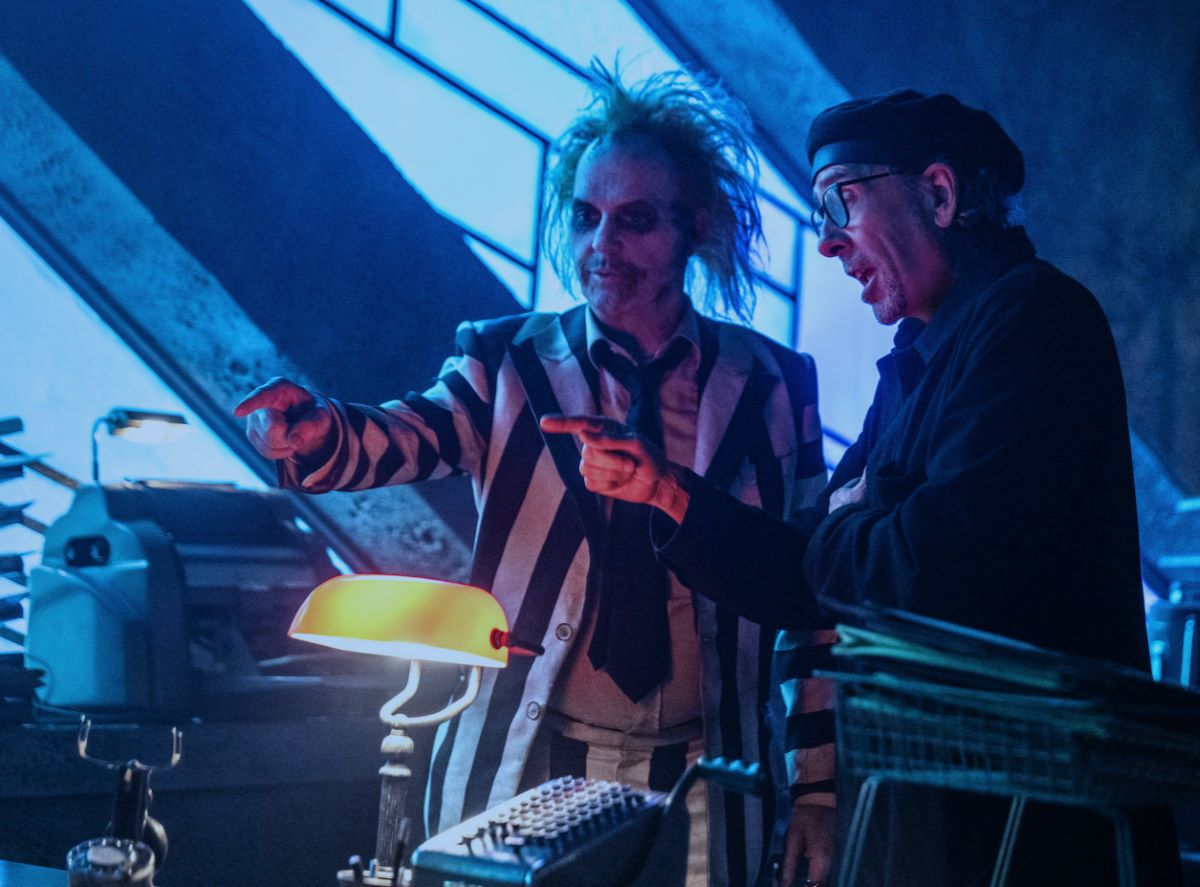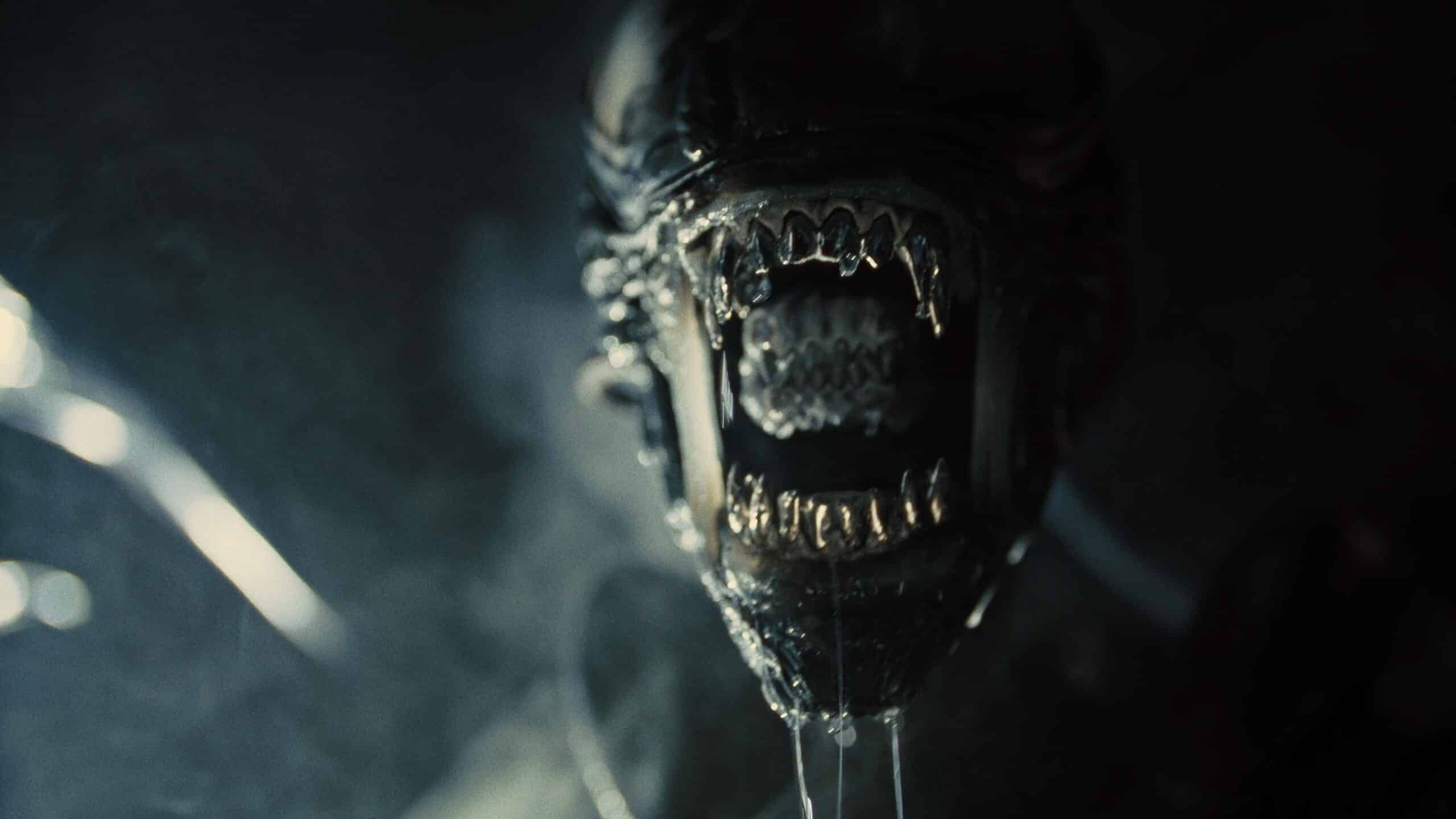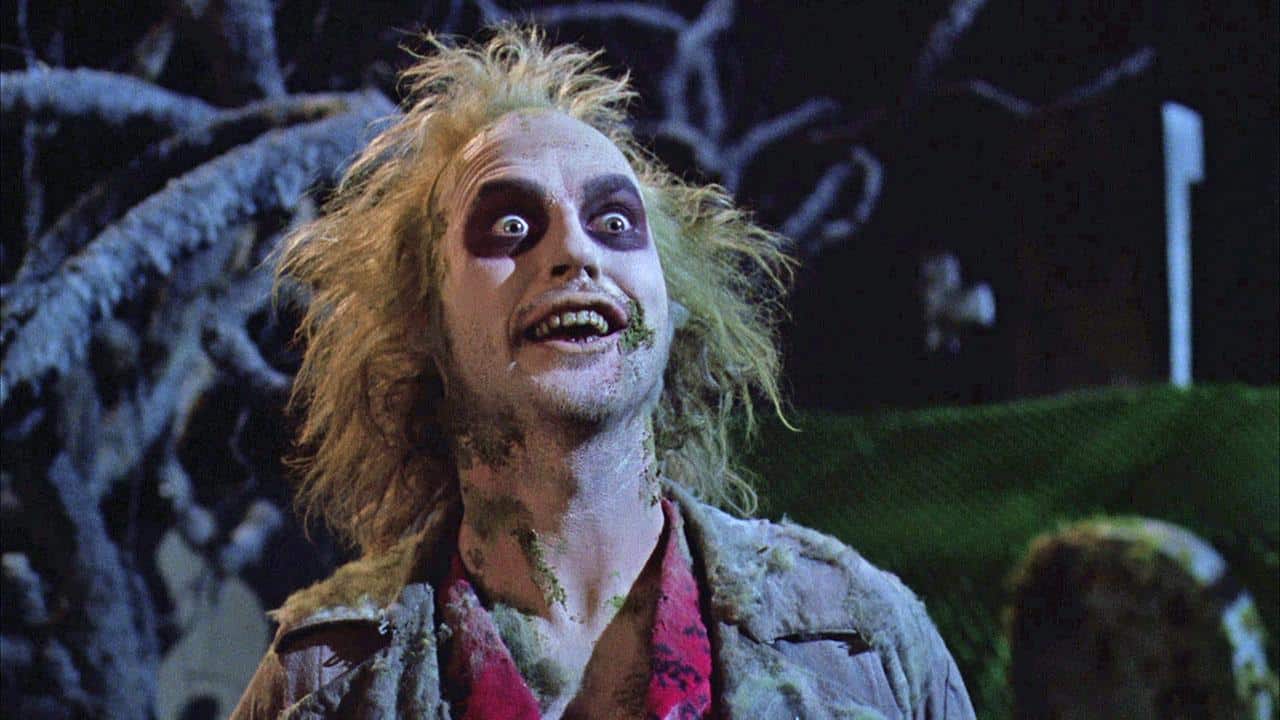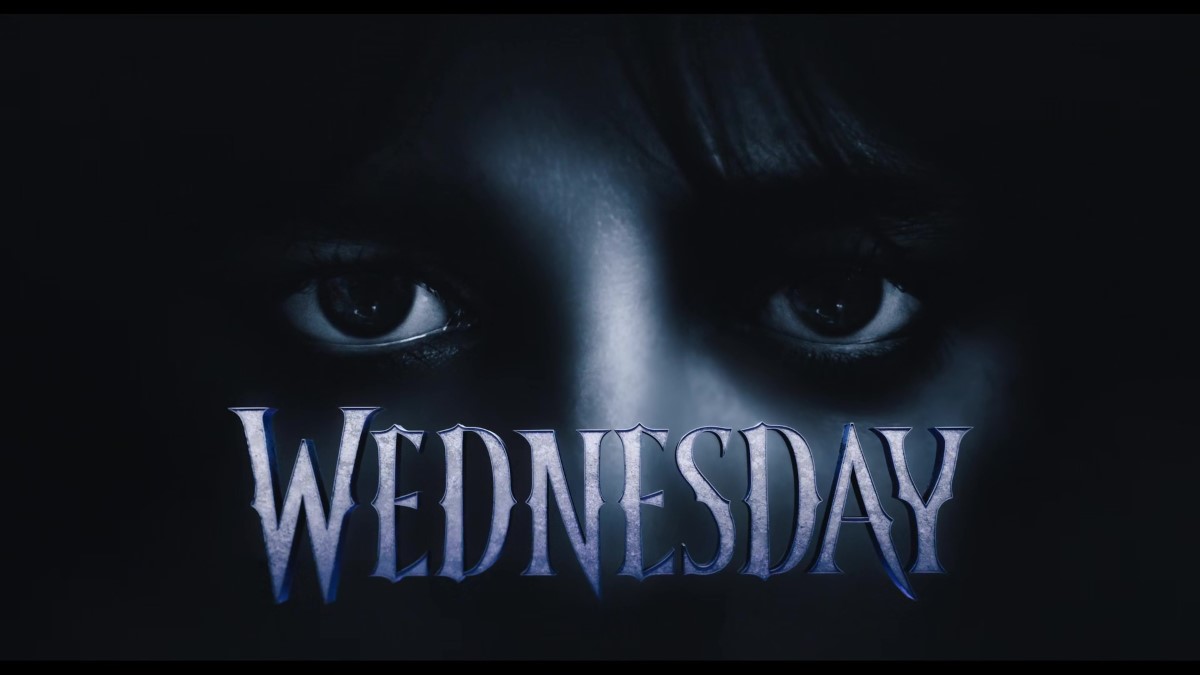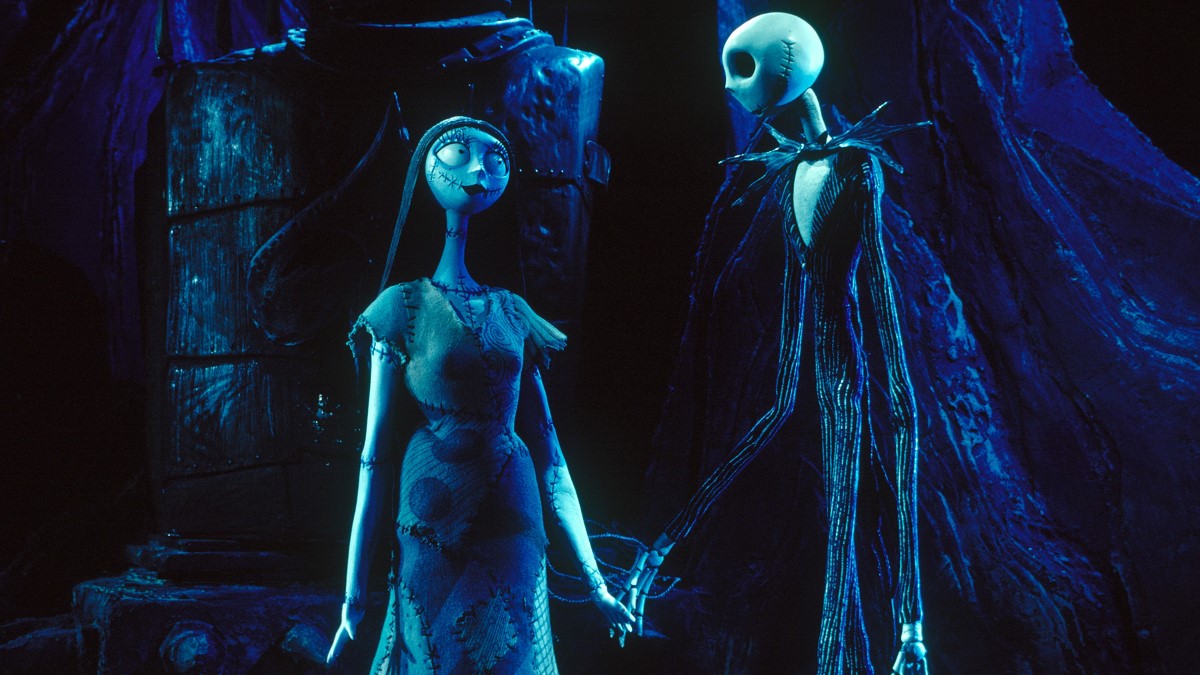Betelgeuse is pacing. Guttural grunts tumble out of his mouth. He’s alone, in the zone, stalking back and forth, oblivious to the surrounding studio activity, the cameras, the crew, the lights.
Betelgeuse. It’s him. The black-and-white striped suit, in dire need of a dry-clean. The lecherous eyes, glaring out from blackened pits. The matted green hair, unwashed. The broken, yellowed teeth, unbrushed. It could be 1988, when Tim Burton’s Beetlejuice (the title a more accessible take on the name) was gifted to unsuspecting cinemagoers like a freakish jack-in-the-box, but somehow it’s 2023, and Betelgeuse, a demon inhabited by Michael Keaton — or is it the other way round? — looks, extra wrinkles aside, the same. Betelgeuse was always somewhat ageless, stuck in time, because he’s dead. Kind of.
“Hell, yeah.” We’re in-between takes at Leavesden Studios, and Keaton is practising his lines, working on inflection, intonation, breathing life back into the filthy bio-exorcist. The world of Beetlejuice is surreal, but not half as surreal as it is for us to be in it, standing a few feet away from the ghost with the most in all his grimy glory. And more ghouls are to come: later we’re introduced to undead unfortunates biding their time in the afterlife, poor souls who died horribly and are now stuck like that. A figure skater, cut in half. A man with a baseball bat sticking out of his eye. An old lady who died alone at home, only to have her insides gnawed on by cats, which remains the situation. We met a handful in Beetlejuice, but there are many more dead people this time around. “Well, you know… It’s 35 years later, of course there are more dead people,” laughs Burton when we bring it up.

The director has been trying to summon Beetlejuice again since around 1990, with various scripts having been written before spluttering away. Finally, though, three-and-a-half decades later, the resurrection is real. Although Beetlejuice Beetlejuice isn’t as much about Betelgeuse as one might presume. It isn’t about death as much as it’s about life. It’s about… time. To some extent, it’s about Burton himself, via Winona Ryder’s returning black sheep Lydia. What does happen when a goth grows up?
Ryder can barely believe this film is here. When we speak to her this April, she is emotionally raw, finding it difficult to articulate how she’s feeling. “I struggle to find the words,” she says, having been stumbling over her thoughts for a while. She explains her state of mind. “This is… you’re the first person I’ve talked to about this. It’s just one of the most special experiences that I’ve ever had. The fact that we’re coming back to it, it’s… It’s beyond”
So, those 1988 dead folk. Deceased denizens of the afterlife. The charred, skeletal corpse offering cigarettes; the guy with the tiny shrunken head, wide eyes popping out of his skull. All performed with, well, deadpan debonaire. Burton didn’t write Beetlejuice, but he might as well have done, so snugly did it fit his skewed sensibilities.
Michael McDowell and Larry Wilson created the bio-exorcist, called upon to scare away unwanted humans — in this case the Deetz family, new owners of the house formerly belonging to freshly dead residents Adam and Barbara Maitland (Alec Baldwin and Geena Davis). Burton, who had made just one feature, 1985’s Pee-wee’s Big Adventure, loved the script’s unorthodoxy and unpredictability, hiring Warren Skaaren to lighten it up: Skaaren doubled-down on the afterlife’s droll bureaucracy, put more emphasis on the morbid Lydia and made Betelgeuse himself more sleazy than sinister. Burton did sketches of what he wanted the character to look like before further shaping him with Keaton, who made some of his own contributions (via make-up artist Ve Neill).
“Tim always saw this dark-black-eyed thing, and the striped suit was him, he had that image in his head,” remembers Keaton now. “But the mould [on his face] and the teeth and the broken nose and the walk and the voice, that was my creation.” On set, much of his dialogue was improvised, his performance an erratic, anarchic one-man show.
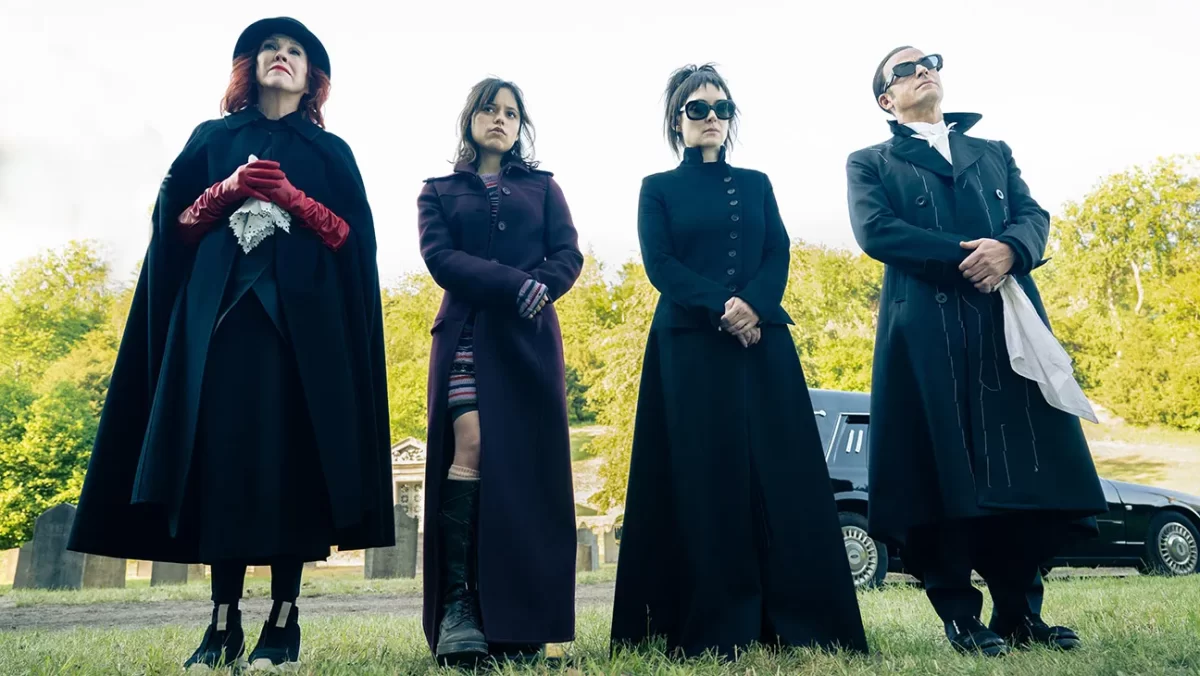
The film, which cost $15 million and made $75 million, introduced Burton’s fully-formed voice to the world. Sequel development began quickly: Skaaren wrote ‘Beetlejuice In Love’ — yes — but that didn’t gain momentum, and Burton hired Jonathan Gems (who later wrote Mars Attacks!) to work on the notoriously titled ‘Beetlejuice Goes Hawaiian’, which the writer later said was a beach movie filtered through German Expressionism — at one point, Betelgeuse uses magic to win a surf contest. Thankfully, that script also went away.
Seth Grahame-Smith (who had written Burton’s Dark Shadows) wrote one, resulting in Ryder, in 2015, announcing that a sequel was happening, but. it didn’t. “There was always talk throughout the years of, ‘What about a Beetlejuice sequel?’ ” says Burton. “Different ideas came up: Beetlejuice goes to Hawaii, Beetlejuice goes to… outer space, I don’t know, whatever we talked about!” None of them really landed, script-wise: “They just didn’t get it,” says Keaton. But then, in early 2022, while Burton was filming his Addams Family-adjacent series Wednesday, starring Jenna Ortega, for Netflix in Romania, the ghoul awakened — and not a moment too soon.
“I actually had sort of lost interest in the movie industry,” he remembers. The Covid-19 pandemic had throttled Hollywood. “It was at a strange juncture in time when everybody was concerned that streaming was going to take over. And I felt like I’d had enough with studios, I’d had enough of all this kind of stuff.” His last film had been 2019’s Dumbo, and he was feeling that maybe, possibly, that would be his actual last film. But Wednesday changed things.
“I’d never done a TV thing before, and it felt like I was going back to basics, going back to just doing something. And being in Romania was this strange, interesting, kind of introspective time, you know, roaming the Carpathian Mountains and thinking and whatever,” he laughs. “And I enjoyed the experience, trying to shoot [what felt] like a movie on a TV schedule, kind of quick — it reenergised me a little bit, and it triggered things about Beetlejuice for me. And I thought, ‘Well, none of us are getting any younger.’ ”
There in the mountains, he approached Wednesday screenwriters Alfred Gough and Miles Millar, told them what he had in mind, showed them a sketchpad already alive with his visual ideas for the film, and hired them to write it (“I gave them a pretty strong pitch — all the key points,” he says). Then he called the cast members he wanted back: Keaton, Ryder and Catherine O’Hara.
“I went and met him,” remembers O’Hara, returning as Lydia’s artist mother Delia. “He said he’d love to get the gang [back] together, and that he would love to get that feeling back that he had on the set in those days, where no-one’s expecting anything and you’re just doing what you really want to do.”
Finally, Betelgeuse had come back to life — and he’d brought Burton’s film career back from the brink too.
In Beetlejuice Beetlejuice, the death of Charles Deetz (Jeffrey Jones in the original film) brings the family — artist Delia, daughter Lydia and her daughter Astrid (Jenna Ortega) — back to the old house in Connecticut’s Winter River (shot, as it was in the first film, in Vermont’s East Corinth). Up in the attic, Astrid finds Adam Maitland’s miniature model of the town, spirits are summoned, and hell literally breaks loose. Or, at least, Betelgeuse. Burton, though, wants to talk about Lydia. She was the key; she always was.
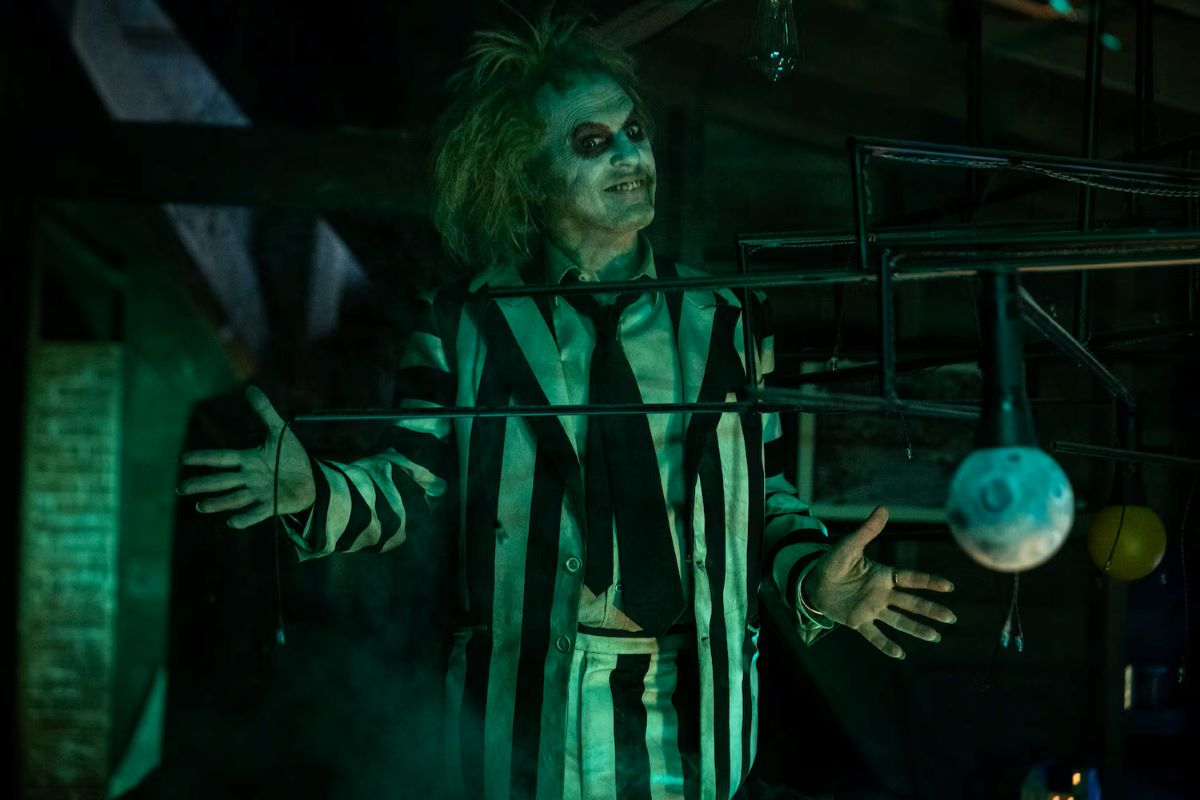
“From the first one, I really identified with Lydia,” he says. “It was a character that I understood, that I felt very strongly about.” Lydia was a teenage goth with a brilliant mind, dressed in black — a physical manifestation of her dark soul. She was… Burtonesque, and the “final hook”, says the director, of firing up the follow-up. “The new film became very personal to me, through the Lydia character. What happened to Lydia? You know, what happens to people? What happens to all of us? What’s your journey from a gothic kind of weird teenager to what happens to you 35 years later?”
As he continues, he clarifies the parallel between himself and Lydia. “Sometimes, as you get older, you lose yourself a little bit,” he explains. “That’s very much how I feel, and felt. You go down a path — for me, I started making movies, I make some good ones, I make some bad, you take a journey. So that’s what made this more of an important and personal thing for me, all those feelings. You have relationships that change you, you have kids that change you. After all these years, that became the reason to make it. I identified with Lydia back then, and I identify with her now.”
It’s at least as personal for Ryder. There’s a fragility to her voice, an openness and intimacy as she talks about returning to what was her breakout role, at 15. If the wry, laconic Lydia was a Burton avatar, she was even more than that for Ryder. “I was that girl,” she says. “Me and Lydia were very, very similar.”
Lydia’s magnificent blacker-than-black clothes in Beetlejuice? Most of them were Ryder’s, ornate garments passed down from previous generations. “This long lace dress that was a little big on me, that belonged to my great grandmother. On that side of my family, that handmade lace, that was what they did in Russia in the 1800s.” And it wasn’t just the clothes. “I actually just found a couple photos of me before I did Beetlejuice, and I was kind of surprised because I had that hair. I dyed my hair, L’Oreal blue-black, by myself. So yeah. that was my general vibe. It was becoming sort of a detriment in the business: I wasn’t even being considered for a lot of roles because I just didn’t have the ’80s look.” It wasn’t a problem for Burton. “Honestly, I really can’t imagine my career trajectory without Tim or Beetlejuice,” says Ryder.
Playing Lydia again, then, has been. heavy. “I don’t know if I’ve ever felt this way,” she says of the work. “This is a first for me. I’ve never revisited a character, ever.”
In Beetlejuice Beetlejuice, Lydia, now living in New York, presents a supernatural TV show, ‘Ghost House With Lydia Deetz’. More significantly, though, she is a mother, to teenager Astrid. Like Burton, the pull for Ryder was in exploring the passing of time. What has changed for Lydia? What remains?
“I mean. that’s the question, right?” she says. “I went through so many stages of, ‘Who is she now?’, but I always wanted to have it be Lydia. She can’t lose who she was. She can’t be the same person, she can’t be just completely deadpan, she has to have evolved, but she also has to have kept that thing she had when we first met her. So that was the big challenge for me. And also my lived experience, even though it’s very different. You know, you grow up, and things change. Life happens.”
Astrid has happened. After Wednesday began airing, Ortega went to Burton’s house to discuss a potential second season. “I knocked on his door and then he plopped a Beetlejuice [Beetlejuice] script in front of me,” she says. This was a surprise. “I went and sat on some rocks and read it there on the side of the freeway.”

If you’ve seen Wednesday, in which Ortega’s gleefully gothic schoolgirl would give Lydia a run for her money, you’d be forgiven for thinking that Astrid is a chip off the old block. She’s not. Astrid, an environmental activist who’s mourning the loss of her father, has a difficult relationship with her mother. “She’s bitter, and upset about the world,” says Ortega, who rewatched Beetlejuice just to “incorporate a little bit of Ryder’s performance into Astrid — but just a little bit. “Lydia is such a precious character. I didn’t want to do a knock-off imitation of her,” says Ortega. “I don’t want there to be comparisons between the two at all.”
Michael Keaton, however, had the opposite challenge. He needed to slip right back in. “I was a little more nervous about it, probably, than I let on,” says Keaton of becoming Betelgeuse again. “It’s such a unique thing. If you don’t get it right the second time it could really not work, and I thought, ‘Well, I just can’t blow this.’ ”
He loved the script — “They got it,” he says of the writers — and began to prep. His biggest mission was to swerve the legend. The legacy. “There’s been so much merchandising of it, I had to drop back to where it started. I had to go, ‘What was my unusual imagination even thinking about when I was developing it in the first place?’ ” he laughs. “As opposed to seeing a coffee mug or a golf-club cover [adorned with Betelgeuse’s face]. That was fucking weird. To be honest with you — I’m being very frank — it was off-putting, to look and go, ‘I don’t want to look like all these little things, fuck that — what was the thing that started this?’ ”
What was it like, though, first day back in that make-up, staring at Betelgeuse’s face through his eyes again? “Really odd,” he says. “Just surreal. But once I got by that I went, ‘Alright, here we go. Let’s go.’ ”
By all accounts, he went. “It was insane,” says O’Hara of Keaton’s work here. “Insane. Betelgeuse has not aged, and Michael’s just so wide-eyed. He’s so alive for a dead guy,” she laughs. Burton remarks — appropriately — that “it was like he was possessed by a demon, because he just went right back into it. Which was a bit scary. It was like time travel.” Ortega was particularly taken aback. “To watch him physically change and appear and Michael Keaton to be gone, and for me to be dealing with this Betelgeuse guy… it blew my mind,” she says. “It was like an animal with a gun had just walked into the room.”
As with Beetlejuice, Keaton wanted to maximise his screentime — of which there isn’t a huge amount. He’s in the original for 17 minutes, and was adamant that this one wouldn’t add up to much more. “I was ultra-clear about that,” he says. “I said, ‘Honestly, we’ll blow it if we do that. We’ll really screw this thing up if we say, “Let’s just have a lot of Betelgeuse.” ’ That would get very tiresome in my opinion.” Whereas other characters have changed over the decades, Betelgeuse has… not. Social progression has not troubled him. “Yes, he’s politically incorrect,” laughs Burton. “But you know what? That’s why I love it.”
Burton wanted the spirit of the 1988 film to permeate this one. Again, much was improvised. “The script was already extremely good,” says Justin Theroux, who plays Lydia’s manager and fiance, Rory, “but Tim has that ability to blow on the coal and let it become even more unhinged.”
Willem Dafoe plays Wolf Jackson, an actor who used to play a cop called Frank Hardballer, died during a stunt and is now head of the Afterlife Crimes Unit. “It’s not a normal role,” says Dafoe. Well, quite. “The most important thing for me was to find the tone. It had to be rooted but it also had to be free enough that you could play with it.” On set, we watch a scene between Wolf — who, thanks to his fatal injury, has a segment of his skull missing — and Betelgeuse. Keaton and Dafoe both twist the dialogue a bit as they go, Burton grinning behind the camera, laughing between takes. Keaton jokes that he and Dafoe should do a “buddy-cop movie” with these characters; at the end of the next take Keaton says, “Copy that, Wolf.” Burton loves it and pushes for more. “Roger that,” says Keaton on the next one.
“I take my cue off of him,” says Dafoe, later, of the riffing. “You take your cue off of the world.”
What a world it is. This scene takes place in the afterlife’s musty Lost And Found department, where dismembered hands stick out of jars. There’s not a green-screen in sight — almost the entire film is being made in-camera, just like the first one was. The Lost And Found department is all forced perspective, the ceiling lights getting smaller and smaller as they reach the back of the room. It’s thrillingly old-school. The same applies to the prosthetics and puppetry. “We made an agreement that it had to be as handmade as possible,” says Keaton. “And we accomplished that.”
Later, we are taken to the afterlife waiting room, meticulously designed to replicate the original, wonky chequered floor and all. Like it has just been there, forever. “It truly felt like you’re in another world,” says Ortega, now, of the sets. “You never wanted to leave. Everything was aged and dusty and gross when you touched it. It was perfect.”
As we leave Leavesden, we see Burton driving himself around in a golf buggy, zipping about speedily before jumping out to go back into the studio. When we’d met him a few hours earlier, he’d been bubbling with energy. Directing on set, he could barely stay still. “He’s constantly being creative,” says Theroux now. “He’s like a kid in class that can’t pay attention to the lesson — he has to be drawing in the margins. At one point he was scribbling things on the backs of [script] sides, doing drawings of little turd monsters. I was wanting someone to run around behind him to collect it all, because they were really good.” We’ll just have to imagine those turd monsters. “I didn’t abscond with any, but I should have,” says Theroux. “I would have framed them.”
Possibly, Burton has always been drawing turd monsters. Despite all the talk of time passing, his creative preoccupations haven’t changed much. He’s still celebrating the misfits and outsiders and, here, reuniting with old collaborators. He has worked with Ryder, Keaton and O’Hara numerous times, and with Wednesday’s Ortega in the mix, let alone returning crew, this is a Burton family reunion. Even to new cast-members, like Monica Bellucci, who plays Delores — a woman from Betelgeuse’s past, her scarred body stapled together as she searches for him in the afterlife — it has been touching. “It was so interesting to see how he was working with Winona and Michael: you could feel the creative energies from all those years between them,” she says. “This film is very personal for him.”
It feels like a Burton supergroup. “It’s beautiful,” he nods now of the experience. “Having all these people, and also Justin, Monica and Willem… it felt very special for me.” Keaton is similarly stoked. “I love it,” he says of the film. “I absolutely love this thing. And I don’t [usually] talk like that. I unabashedly love this. It was not easy to pull off, and I think we did it in spades.”
Ryder, having been emotional throughout our conversation, only becomes more so as we continue. “My eyes are welling up right now, because it means so much to me,” she says. “It means so, so much to me. Every moment that I was on that set, I was like, ‘I have to be so present for this because this (whispers) never happens and this is amazing.”
And for Burton, who was done with the movie industry, it’s been a lifeline. How’s he feeling now? “Great,” he says. “Honestly, I rarely say that — I’m not the most… outwardly positive person! So. it did the job,” he laughs.
Hell, yeah.
Beetlejuice Beetlejuice is in cinemas from September 6, 2024
Empire UK, July 2024

